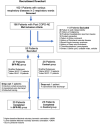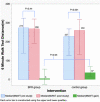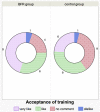Effect on muscle strength after blood flow restriction resistance exercise in early in-patient rehabilitation of post-chronic obstructive pulmonary disease acute exacerbation, a single blinded, randomized controlled study
- PMID: 37976375
- PMCID: PMC10657539
- DOI: 10.1177/14799731231211845
Effect on muscle strength after blood flow restriction resistance exercise in early in-patient rehabilitation of post-chronic obstructive pulmonary disease acute exacerbation, a single blinded, randomized controlled study
Abstract
Background: Early commencement of rehabilitation might counteract the loss of muscle strength due to a chronic obstructive pulmonary disease acute exacerbation (COPDAE). Blood flow restriction resistance exercise (BFR-RE) using a low intensity of training load has demonstrated muscle strength gain in varieties of clinical populations. This trial aimed at studying the efficacy and acceptability of BFR-RE in patients with post-COPDAE which was not reported before.
Method: A prospective, assessor blinded, randomized controlled study with 2-week in-patient rehabilitation program with BFR-RE was compared to a matched program with resistance exercise without BFR in patients with post-COPDAE. The primary outcome was the change of muscle strength of knee extensor of dominant leg. The secondary outcomes included changes of hand grip strength (HGS), 6-minute walk test (6MWT) distance, short physical performance battery (SPPB) scores, COPD assessment test (CAT) scores; acceptability and feasibility of BFR-RE; and 1-month unplanned re-admission rate.
Results: Forty-Five post-COPDAE patients (mean age = 76 ± 10, mean FEV1%=49% ± 24%) were analyzed. After training, BFR-RE group and control group demonstrated a statistically significant median muscle strength gain of 20 (Interquartile range (IQR) 3 to 38) Newton(N) and 12 (IQR -9 to 30) N respectively. BFR-RE group showed a significant change in SPPB scores, but not in 6MWT distance and HGS after training. Between groups did not have statistically significant different in all primary and secondary outcomes, though with similar acceptability. Drop-out rate due to training-related discomfort in BFR-RE group was 3.7%.
Conclusion: BFR-RE is feasible and acceptable in patients with post-COPDAE. A 2-week inpatient pulmonary rehabilitation with BFR-RE improved muscle strength of knee extensors, but not a greater extent than the same rehabilitation program with resistance exercise without BFR. Further studies could be considered with a longer training duration and progression of resistance load. [ClinicalTrials.gov Identifier: NCT04448236].
Keywords: Blood flow restriction resistance exercise; chronic obstructive pulmonary disease acute exacerbation; muscle strength; pulmonary rehabilitation.
Conflict of interest statement
Declaration of conflicting interestsThe author(s) declared no potential conflicts of interest with respect to the research, authorship, and/or publication of this article.
Figures







References
-
- Jaitovich A, Barreiro E. Skeletal Muscle Dysfunction in Chronic Obstructive Pulmonary Disease. What We Know and Can Do for Our Patients. Am J Respir Crit Care Med 2018; 198(2): 175–186. DOI: 10.1164/rccm.201710-2140CI. Erratum in: Am J Respir Crit Care Med 2018; 198(6): 824–825. PMID: 29554438; PMCID: PMC6058991. - DOI - PMC - PubMed
Publication types
MeSH terms
Associated data
LinkOut - more resources
Full Text Sources
Medical
Miscellaneous

